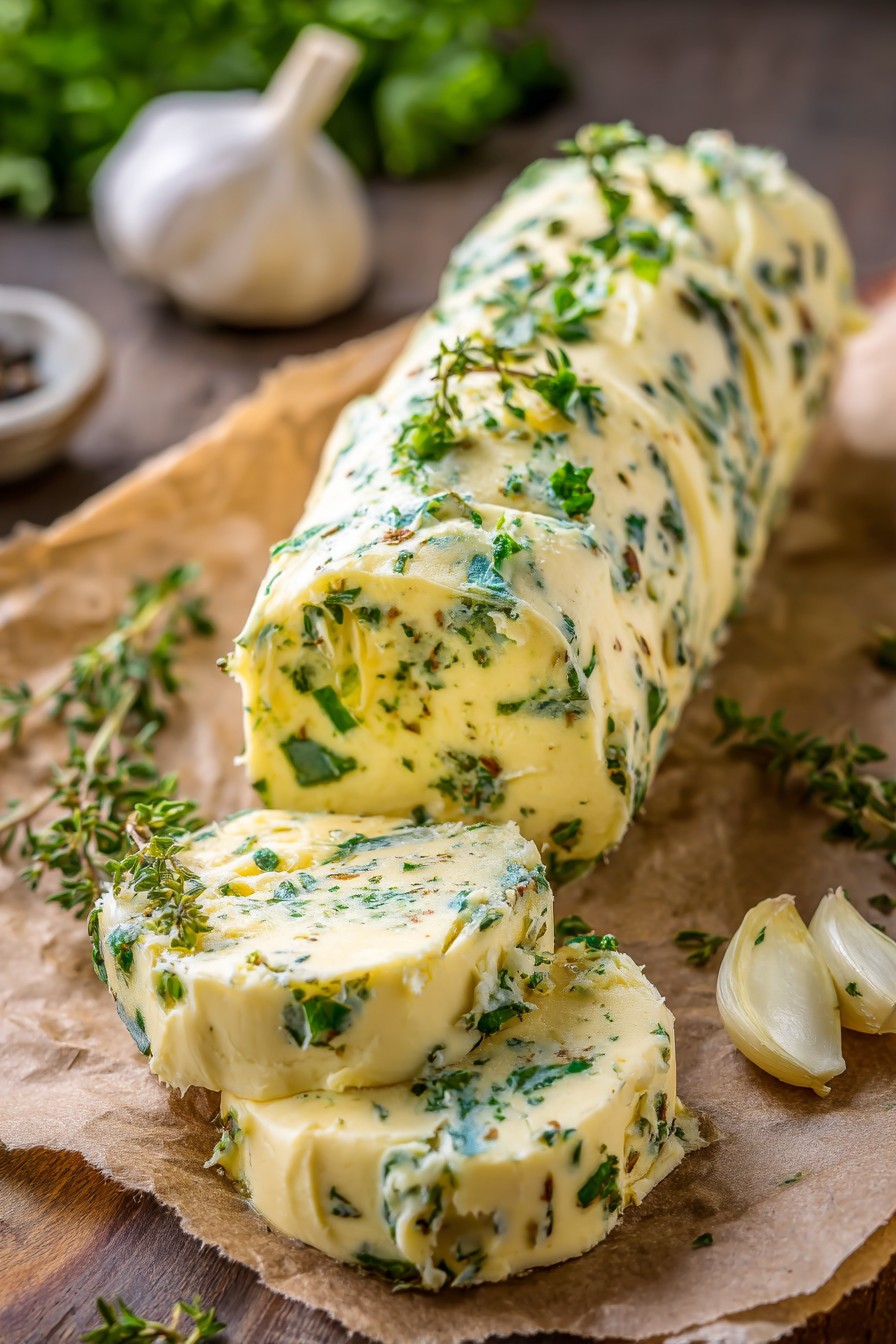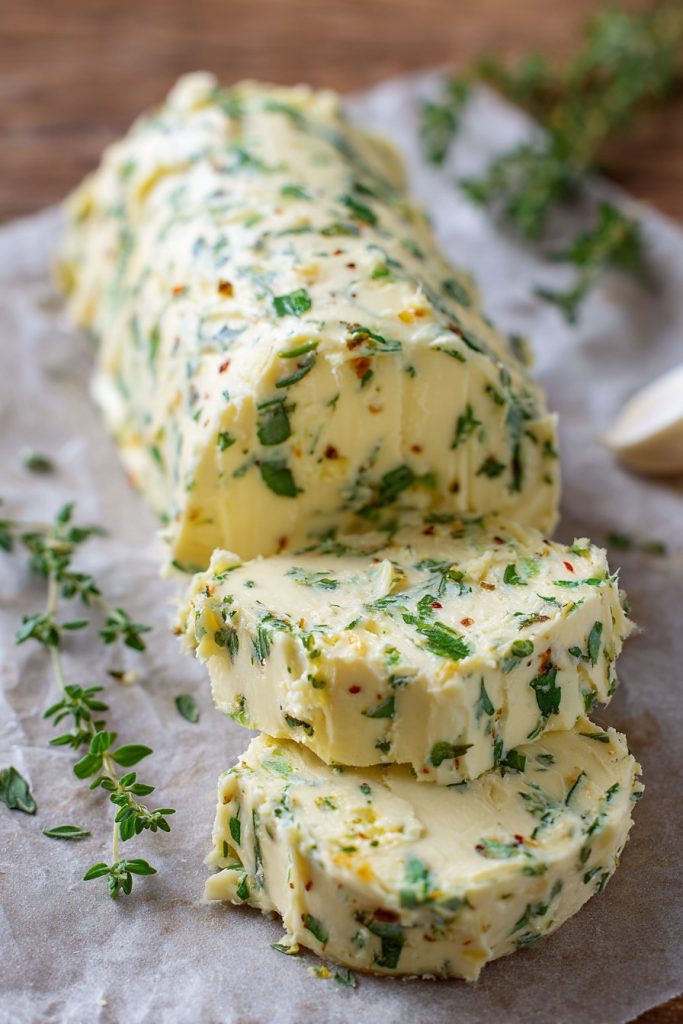From the bustling markets of Provence to the cozy trattorias of Rome, garlic butter has been the unsung hero of global cuisine for centuries. This simple yet transformative compound butter carries the soul of Mediterranean kitchens and the warmth of French country cooking in every golden spoonful. Today we’ll craft this culinary treasure that bridges continents and elevates everyday meals into extraordinary experiences.
Why This Recipe Works
- The slow-roasting technique for garlic transforms its sharp pungency into a deep, caramelized sweetness that permeates every molecule of butter, creating layers of flavor reminiscent of sun-drenched Tuscan kitchens where time-honored methods yield extraordinary results
- Using high-quality European-style butter with its higher fat content creates a richer, creamier texture that melts luxuriously over warm bread or sizzles perfectly in pans, echoing the dairy traditions of Normandy where butter is considered an art form
- The careful balance of fresh herbs and citrus zest introduces bright, aromatic notes that dance across the palate, much like the vibrant flavors found in Greek tavernas where lemon and oregano sing in harmony with garlic
- Proper resting and chilling allows the flavors to marry and intensify, developing the complex profile that makes French beurre composé so legendary in professional kitchens across Paris
- The versatility of this recipe serves as a culinary passport, adapting beautifully to everything from Italian garlic bread to French escargot, proving that great food transcends borders
Ingredients
- 1 cup (2 sticks) high-quality unsalted European-style butter, softened at room temperature for 2 hours
- 8 large garlic cloves, peeled and roasted until golden brown and fragrant
- 2 tablespoons fresh parsley, finely chopped with stems removed
- 1 teaspoon fresh thyme leaves, stripped from woody stems
- 1/2 teaspoon fine sea salt, preferably French fleur de sel
- 1/4 teaspoon freshly cracked black pepper, coarsely ground
- 1 teaspoon fresh lemon zest, finely grated from an unwaxed lemon
- 1 tablespoon fresh lemon juice, freshly squeezed and strained
Equipment Needed
- Small baking sheet for roasting garlic
- Aluminum foil for wrapping garlic
- Medium mixing bowl
- Rubber spatula for folding ingredients
- Garlic press or microplane zester
- Parchment paper for rolling
- Sharp chef’s knife
- Cutting board
- Measuring spoons
- Airtight container for storage
Instructions

Prepare the Roasted Garlic
Begin by transforming your raw garlic cloves into sweet, caramelized gems that will form the foundation of your compound butter. Preheat your oven to 400°F and place eight peeled garlic cloves on a small piece of aluminum foil. Drizzle the cloves with just a teaspoon of olive oil—this small addition helps conduct heat evenly and prevents burning while enhancing the natural sugars. Fold the foil into a tight packet, creating a miniature steam oven that will gently roast the garlic over the next 35-40 minutes. The transformation occurs gradually: at 20 minutes, the sharp edges soften; by 30 minutes, golden hues emerge; and at the 35-minute mark, your kitchen fills with that unmistakable sweet, nutty aroma that signals perfectly roasted garlic. Remove from oven and let cool completely—this patience ensures your butter won’t separate when mixed. Pro tip: For deeper flavor, consider roasting a whole head of garlic and reserving extra cloves for other Mediterranean-inspired dishes.
Combine Base Ingredients
Incorporate Fresh Herbs and Citrus
This step introduces the vibrant, aromatic elements that elevate our garlic butter from simple to sublime. Begin by finely chopping two tablespoons of fresh flat-leaf parsley—its bright, clean flavor cuts through the richness while adding visual appeal. Strip one teaspoon of fresh thyme leaves from their woody stems, releasing their earthy, slightly minty aroma that whispers of Provençal herb gardens. Using a microplane, zest one teaspoon of lemon rind, taking care to avoid the bitter white pith beneath—this citrus kiss brightens the entire composition. Now add these elements to your butter mixture along with the half teaspoon of sea salt and quarter teaspoon of black pepper. Fold everything together with deliberate, gentle strokes until the herbs are evenly distributed like confetti throughout the golden butter. The transformation is immediate—what was once simple becomes complex, aromatic, and alive with Mediterranean character.
Balance with Acid and Seasoning
The final flavor balancing act requires precision and intuition, much like a Venetian chef adjusting their signature sauce. Squeeze one tablespoon of fresh lemon juice through a strainer to remove seeds and pulp, then drizzle it gradually into your butter mixture while continuously folding. Observe how the acid brightens the flavors—the rich butter becomes livelier, the garlic more pronounced, the herbs more aromatic. Now comes the crucial tasting moment: take a small amount on a clean spoon and evaluate. Does it need more salt to enhance the garlic? Perhaps another crack of pepper for warmth? Adjust gradually, remembering you can always add but never remove. The perfect balance should sing with clarity—richness from the butter, sweetness from garlic, freshness from herbs, brightness from citrus, and depth from seasoning, all in harmonious conversation.
Shape and Chill to Perfection
The final transformation turns our flavorful mixture into a usable, beautiful product that honors both French technique and practical home cooking. Lay a 12-inch piece of parchment paper on your work surface and transfer the butter to the center. Using your spatula, shape it into a rough log about 6-8 inches long. Now employ the classic French technique of rolling: lift the parchment edge closest to you and gently push the butter forward while tucking the paper underneath, creating tension that forms a smooth cylinder. Continue rolling until the butter is completely wrapped, then twist the ends like a candy wrapper to secure. Refrigerate for at least 4 hours—this crucial resting period allows the flavors to marry and intensify while firming the butter to perfect sliceable consistency. For longer storage, this wrapped log can be frozen for up to three months, ready to transport your taste buds to the Mediterranean whenever the craving strikes.
Tips and Tricks
Beyond the basic recipe lies a world of technique and nuance that separates good garlic butter from extraordinary. Consider sourcing your butter from local creameries if possible—the terroir of the pasture actually influences the flavor profile, much like wine grapes. For garlic enthusiasts, try black garlic instead of roasted—its fermented, balsamic-like notes create an entirely different dimension that pairs beautifully with Asian-inspired dishes. When working with herbs, always chop them just before incorporating to preserve their volatile oils, which carry the true essence of their flavor. If you find yourself without European butter, you can simulate the higher fat content by gently melting American butter and skimming off the milk solids that rise to the top, though this requires additional time and care.
Storage becomes an art in itself—while refrigeration maintains freshness, consider dividing your batch into multiple smaller portions flavored differently: one with added Calabrian chili for heat, another with smoked paprika for depth, a third with preserved lemon for North African flair. When using your garlic butter for cooking, remember that it has a lower smoke point than plain butter due to the milk solids and garlic content, so moderate your heat accordingly to prevent burning. For presentation, you can roll your finished butter in additional chopped herbs, cracked pepper, or even edible flowers before chilling to create a stunning visual effect worthy of any Parisian bistro. And never underestimate the power of temperature—allow your garlic butter to sit at room temperature for 15-20 minutes before serving to release its full aromatic potential, much like letting a fine cheese breathe before enjoyment.
Recipe Variations
- Mediterranean Herb Explosion: Transport your taste buds to the Greek islands by adding two tablespoons each of finely chopped fresh oregano, dill, and mint along with a teaspoon of grated orange zest. The oregano brings earthy warmth reminiscent of sun-baked hillsides, while the dill offers feathery freshness that pairs beautifully with fish. Mint provides a cooling counterpoint to the garlic’s richness, and orange zest introduces a sunny Mediterranean brightness that makes this variation perfect for lamb dishes or spread on warm pita bread.
- Spicy Calabrian Chili Infusion: For those who crave heat, incorporate two tablespoons of finely chopped Calabrian chilies along with a teaspoon of their fragrant oil. These Italian chilies offer complex fruity heat rather than simple burn, with notes of cherry and smoke that dance elegantly with the roasted garlic. Add a pinch of smoked paprika to enhance the depth, creating a butter that transforms simple pasta dishes into Neapolitan masterpieces or adds fiery sophistication to grilled seafood.
- French Forest Mushroom: Channel the earthy elegance of Burgundian cuisine by sautéing one cup of finely chopped wild mushrooms (such as porcini, chanterelle, or morel) until deeply browned, then cooling and folding into the base recipe. The mushrooms contribute an umami richness that complements the sweet roasted garlic, while their forest-floor aroma creates incredible depth. This variation shines when melted over steak or stirred into risotto, bringing a taste of the French countryside to your table.
- Asian Fusion: Create an East-meets-West masterpiece by replacing the traditional herbs with two tablespoons of finely chopped cilantro, one tablespoon of minced lemongrass, and a teaspoon of grated ginger. The cilantro brings bright, citrusy notes, while lemongrass adds floral complexity and ginger provides warming spice. A dash of fish sauce (yes, really!) amplifies the umami, making this variation incredible for seafood, stir-fries, or even corn on the cob with an unexpected global twist.
Frequently Asked Questions
Can I use raw garlic instead of roasted in this recipe?
While technically possible, using raw garlic fundamentally changes the character of your garlic butter and comes with significant drawbacks. Raw garlic possesses a sharp, pungent heat that can overwhelm the delicate balance of flavors and may cause digestive discomfort for some people. The roasting process transforms the garlic’s natural allicin compounds, mellowing their intensity while developing deep caramelized sweetness and nutty complexity. Additionally, raw garlic tends to grow stronger and more bitter over time in the butter, whereas roasted garlic maintains its mellow profile. If you must use raw, reduce the quantity by half and consider blanching the cloves first to remove some of the harshness, though this still won’t achieve the same depth of flavor that makes this recipe special.
How long does homemade garlic butter last in the refrigerator?
Properly stored in an airtight container, your homemade garlic butter will maintain optimal quality for about two weeks in the refrigerator. The high salt content and acidic elements from the lemon juice help inhibit bacterial growth, while the refrigeration slows oxidation. For longer preservation, freezing is your best option—the butter log can be kept frozen for up to three months without significant quality loss. When freezing, I recommend slicing the log into individual portions before wrapping tightly, allowing you to remove only what you need. Always trust your senses: if the butter develops off odors, unusual coloration, or shows signs of mold, it’s best to discard it, though properly handled garlic butter rarely reaches this point before being deliciously consumed.
What’s the difference between European-style and regular American butter?
The distinction lies primarily in butterfat content and production methods, which create noticeably different results in both flavor and performance. European-style butter typically contains 82-86% butterfat compared to American butter’s 80%, achieved through longer churning that removes more water. This higher fat content translates to richer flavor, creamier texture, and better emulsification properties. Additionally, many European butters undergo culturing—a fermentation process that develops tangy, complex flavors absent in most American varieties. In garlic butter, these differences manifest as superior silkiness, more pronounced dairy notes, and better ability to carry and meld flavors. While you can use American butter, the final product will be slightly less rich and may have a looser consistency when melted.
Can I make this recipe dairy-free or vegan?
Absolutely, and the results can be surprisingly delicious with the right substitutions. For vegan garlic butter, replace dairy butter with high-quality vegan butter sticks—look for brands with minimal ingredients and good melting properties. The roasted garlic technique works identically, though you may want to increase the quantity slightly to compensate for the different base flavor. For herbs and seasonings, follow the original recipe exactly. One adjustment worth considering: add a teaspoon of nutritional yeast to mimic the slight umami depth that dairy butter provides. The chilling and rolling process remains the same, and your vegan garlic butter will work beautifully in all the same applications, from garlic bread to vegetable sautés, bringing global flavor to plant-based cooking.
Summary
This homemade garlic butter recipe transforms simple ingredients into culinary gold through careful technique and global inspiration. The slow-roasted garlic develops deep sweetness, while quality butter and fresh herbs create complex layers of flavor that elevate everything from bread to seafood. Proper resting ensures perfect texture and married flavors worthy of any international kitchen.
Homemade Garlic Butter
6
servings15
minutes40
minutesIngredients
Instructions
- 1 Preheat oven to 400°F. Place garlic cloves on foil, drizzle with oil, wrap tightly, and roast for 35-40 minutes until golden and fragrant. Cool completely.
- 2 In medium bowl, cream softened butter until pale and fluffy using rubber spatula.
- 3 Mash roasted garlic into paste and fold into butter until fully incorporated.
- 4 Add chopped parsley, thyme leaves, lemon zest, salt, and pepper. Fold until evenly distributed.
- 5 Gradually add lemon juice while folding, then adjust seasoning to taste.
- 6 Transfer to parchment paper, shape into log, roll tightly, twist ends, and refrigerate 4 hours before use.



